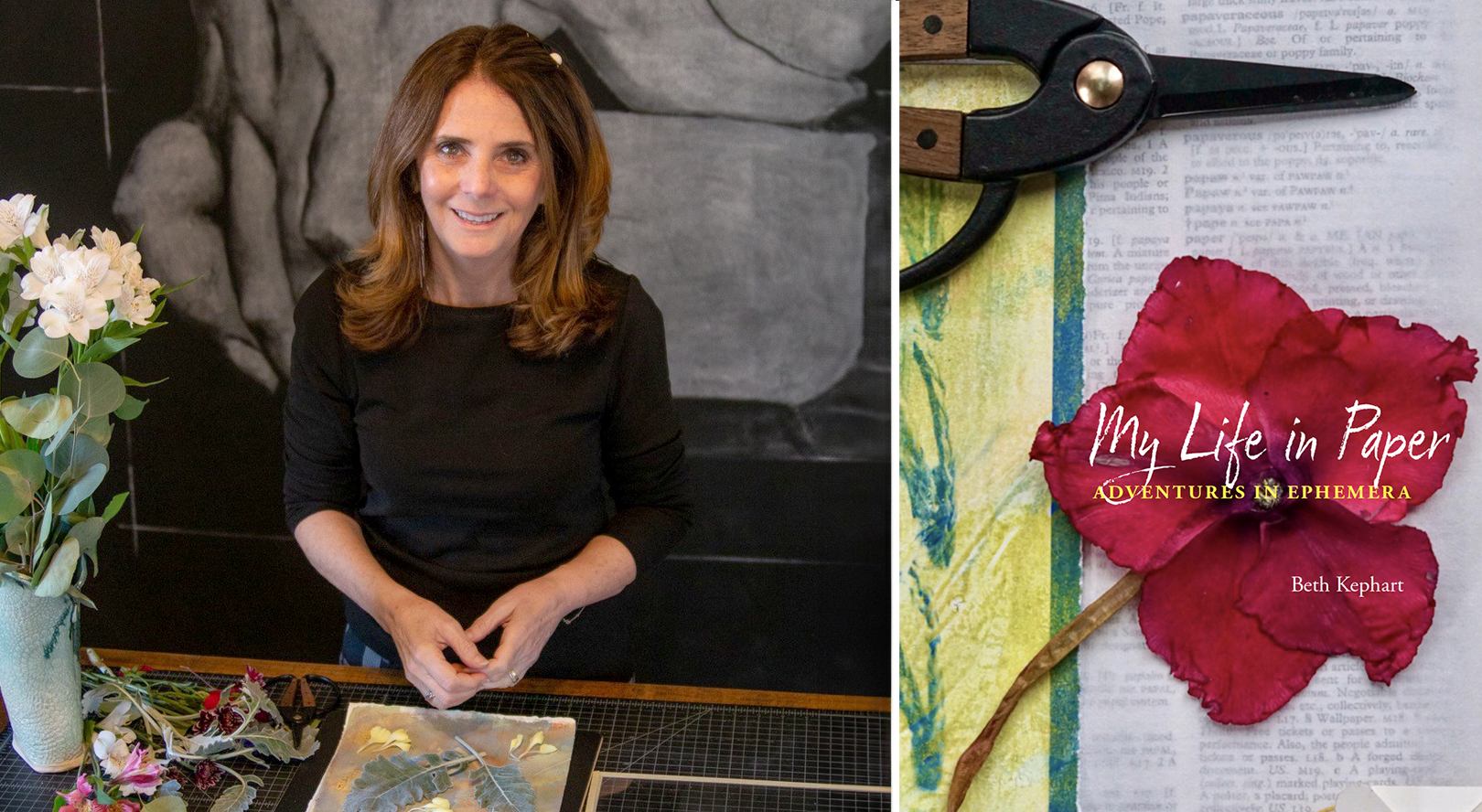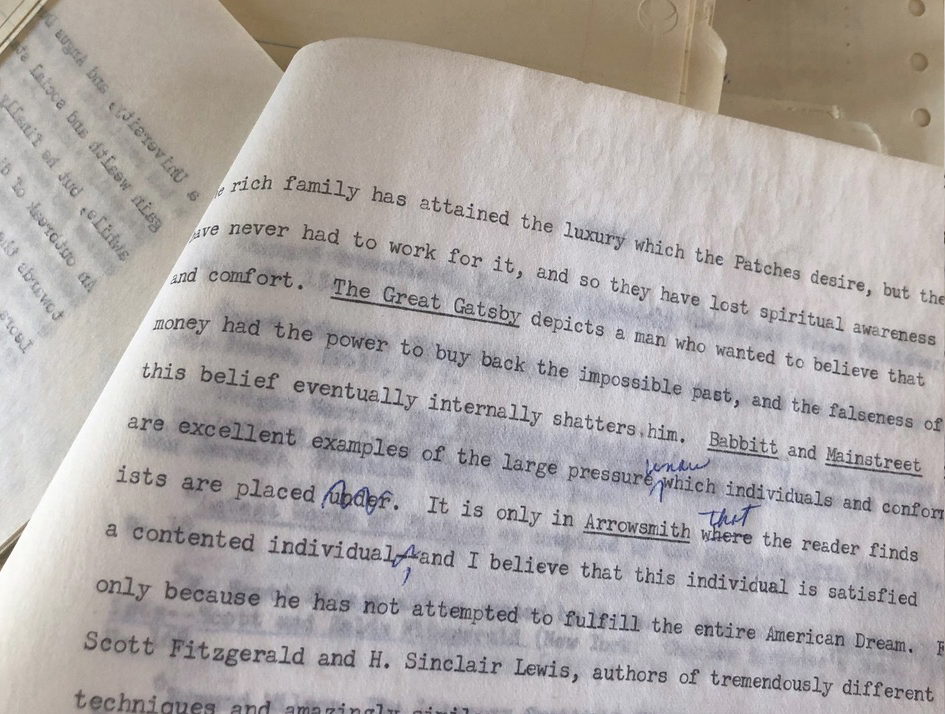A Paper Tale
English lecturer Beth Kephart’s new memoir focuses on the paper that marks and memorializes our lives, from baby books to wills.

A sample of Kephart’s handmade paper, which includes pulp from her books, pom pom flowers, chrysanthemumum petals, thyme, and okra.
A postcard. A movie ticket. A child’s drawing. Though they’re just pieces of paper, they embody a piece of our lives. In My Life in Paper: Adventures in Ephemera, Beth Kephart traces her past and the people in it by examining the paper she’s kept. The subjects of the book’s short essays include baby books, homework, sewing patterns, library cards, diplomas, and death certificates.
The idea stemmed from “memoirs in pieces” she’s been writing lately, constructed of organized fragments. Paper seemed a natural candidate. “It was very interesting to me to put together the puzzle of the book,” says Kephart, an award-winning writer and lecturer in the English department who has authored 40 books for adults and children, including several memoirs. She began with remembering: “The scrapbook, the photograph, menu, homework, diary.”
Kephart writes about each element in an intimate, personal way and then adds something universal or historical. “For sheet music, for instance, I wrote about my father and brother playing music on Christmas Eve, but I also wrote about the first song written expressly for the United States, Alexander Reinagle’s ‘Federal March,’ and how it was played in Philadelphia for a parade with all the trades in the city represented—and it’s still played today,” she explains. “We all have these very personal stories that might be triggered by sewing patterns or sheet music, but it all comes from a historical and shared space, and I wanted to highlight the bridge between.”
Interspersed between essays are letters to the late Dard Hunter, a man who lived from 1883 to 1966 and was, Kephart says, “obsessed with paper.” My Life in Paper was inspired when Kephart’s brother gave her a copy of Hunter’s My Life with Paper that had belonged to their late mother. Hunter had spent much of his life traveling to learn how paper is made around the world. He’d return home, make paper, create his own type, and print books about what he’d learned. He even built papermills. But ultimately, says Kephart, Hunter felt his life had been unsuccessful.
“I had great empathy for this man,” Kephart says. “Dard Hunter felt extraordinarily real to me—his desires and passions and failures. It was a time when I was teaching and it was COVID, when I felt like I was failing a lot, and for some reason, Dard Hunter was the person I wanted to talk with about things like home and craft and remembering and obsession. I felt I could bind his story in while addressing him in a very urgent, personal, timely way.”
Like Hunter, Kephart herself also learned how to make paper. “It’s just a true joy,” she says. “The endpapers in the book are my marbling. I’ve made paper out of mushrooms, with flowers, with grass. What I love about it is that it has a history,” she explains. “Once these fibers were loose, and then water and pressure and time and all the other processes, sometimes chemicals, bound them, and that says something to me about human possibility. What is a relationship but disparate fibers bound together? What is a community but that?”
As life becomes increasingly digital, Kephart celebrates paper’s tactile nature and unique properties. “Paper is embedded with the human touch,” she says. She remembers finding the index card where her father had written his wishes for Kephart and her new husband on their wedding day. “It was folded into quarters, which he must have kept in his breast suit pocket.”
There’s a more formal form of discovery, too. “How wonderful it is to sit in that part of the library and have the experts bring you a box? You’ve got your gloves on and it feels like a pulpit or something, and everybody's wondering what’s in the box. It’s very exciting,” she says, adding that if everything were just on screens, we’d lose that shared moment of discovery.
Finally, paper is a testament to what we choose to save. “If we were without paper archives, we would know a lot less about how we think and how we love and what mattered to people,” Kephart says. “With digital, it’s like, ‘I’ll just keep it all. Someone else will figure it out.’” And though paper is fragile, it is portable, physical evidence that takes more to destroy than the click of a button or an electromagnetic pulse. The letters, postcards, and even menus hold our lives, evoking memories long-since forgotten when the papers suddenly resurface.
Ultimately, Kephart says she wants to inspire her readers to think about how paper has affected them, and about obsession and failure. “I never want to write a book that is a showpiece for the way I think or what I love about language,” Kephart says. “I’m interested in writing books that leave the reader somehow bigger in their thinking about life.”
Top image: A sample of Kephart’s handmade paper, which includes pulp from her books, pom pom flowers, chrysanthemumum petals, thyme, and okra.




